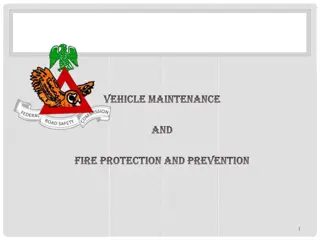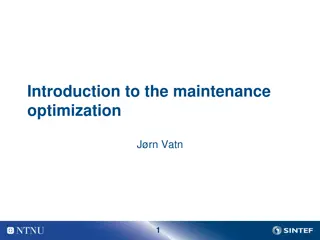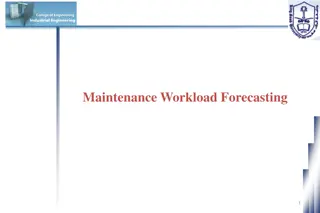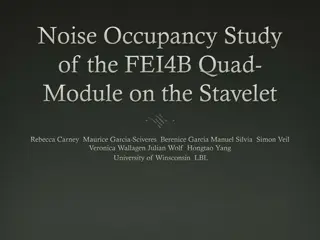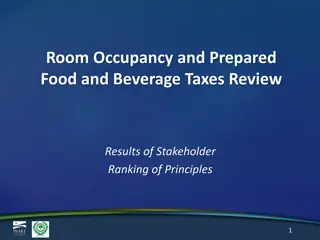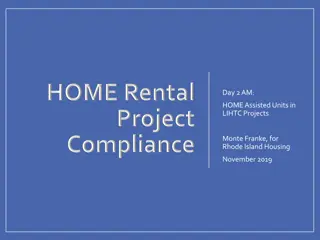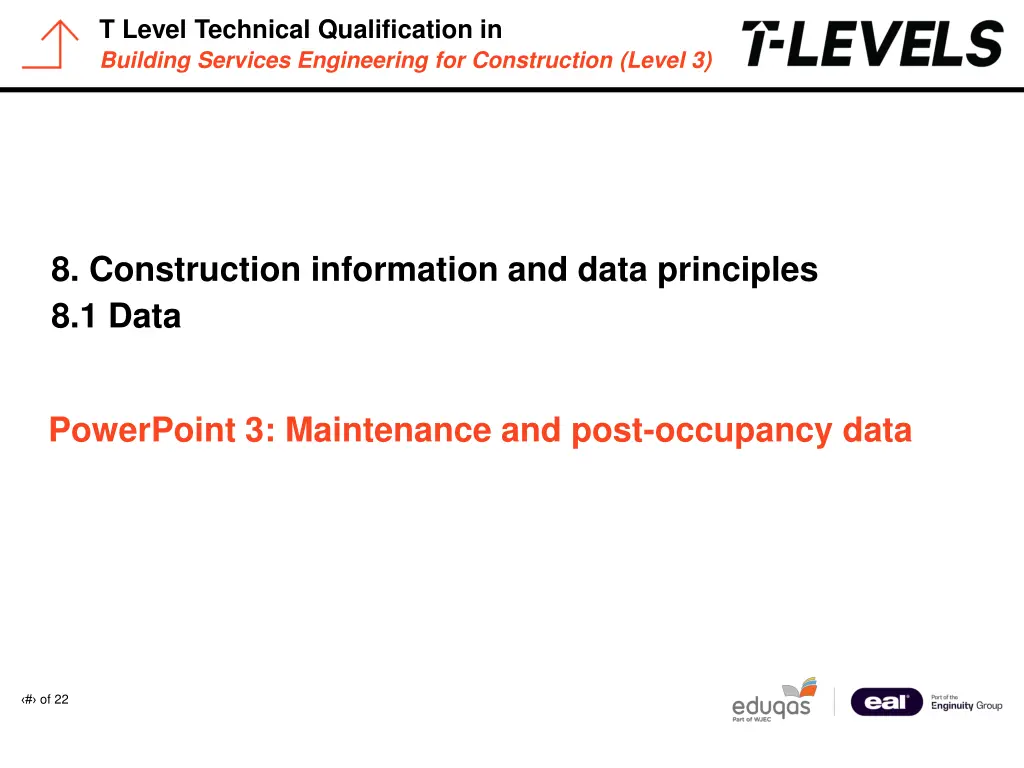
Maintenance Principles in Building Services Engineering
Explore the importance of maintenance in building services engineering, including principles, types, and strategies to ensure structural stability, safety, and efficient operations. Learn how maintenance can prevent various undesirable outcomes and optimize building performance for occupants.
Download Presentation

Please find below an Image/Link to download the presentation.
The content on the website is provided AS IS for your information and personal use only. It may not be sold, licensed, or shared on other websites without obtaining consent from the author. If you encounter any issues during the download, it is possible that the publisher has removed the file from their server.
You are allowed to download the files provided on this website for personal or commercial use, subject to the condition that they are used lawfully. All files are the property of their respective owners.
The content on the website is provided AS IS for your information and personal use only. It may not be sold, licensed, or shared on other websites without obtaining consent from the author.
E N D
Presentation Transcript
T Level Technical Qualification in Building Services Engineering for Construction (Level 3) 8. Construction information and data principles 8.1 Data PowerPoint 3: Maintenance and post-occupancy data # of 22
T Level Technical Qualification in Building Services Engineering for Construction (Level 3) Data sources There are a variety of data sources which are used in construction and building services engineering. Data from these sources can be used to understand behaviour, assess performance, improve market competitiveness, allocate resources and manage costs. In this presentation we look at: maintenance and replacement systems post-occupancy evaluation. # of 22
T Level Technical Qualification in Building Services Engineering for Construction (Level 3) Maintenance principles Maintenance is carried out to: maintain structural stability and safety and prevent decay and degradation ensure availability of important assets prevent loss of core business due to failure of service systems. It can also prevent undesirable outcomes, such as: non-compliance with legal requirements customer dissatisfaction health and safety breaches inefficient and wasteful energy consumption environmental loss the excessive cost of catastrophic plant failures. # of 22
T Level Technical Qualification in Building Services Engineering for Construction (Level 3) Maintenance principles Maintenance can also help to: determine the causes of defects and help prevent reoccurrence or repetition prevent unnecessary damage from the weather or from general usage inform plans for renovation, refurbishment, retrofitting or new buildings optimise performance of the building for its occupants. # of 22
T Level Technical Qualification in Building Services Engineering for Construction (Level 3) Maintenance types Planned maintenance on a regular basis. Preventive maintenance to maintain working order or extend life. Corrective maintenance, eg repairs. Front-line maintenance, eg repainting and decorating an occupied building. Proactive maintenance undertaken to avoid failures or identify defects that could lead to failure. Reliability-centred maintenance, combining maintenance strategies to ensure a physical asset continues to function correctly. Scheduled maintenance, which is preventive maintenance carried out in accordance with predetermined intervals, number of operations, hours run, and so on. # of 22
T Level Technical Qualification in Building Services Engineering for Construction (Level 3) Computerised managed maintenance system (CMMS) A CMMS is a computer-based software information source for maintenance management. It evolved in the late 1980s and early 1990s as building professionals began to use computer-aided design and facilities management (CAFM) tools. CMMS helps organise and automate the record-keeping process. As a type of work order management system, CMMS uses data collected from equipment located throughout a facility to monitor inventory, track work orders, generate reports and initiate preventive maintenance actions. # of 22
T Level Technical Qualification in Building Services Engineering for Construction (Level 3) Work order management systems and CMMS Work order management systems use a dashboard to track and manage relevant maintenance projects and processes for facilities managers. Such systems are suitable for multi-site organisations and can be integrated with enterprise asset management software (EAM) or CMMS. CMMS can also help maintenance planners, engineers and supervisors to schedule, monitor and execute maintenance tasks in compliance with regulations and health and safety requirements. # of 22
T Level Technical Qualification in Building Services Engineering for Construction (Level 3) Replacement systems In some circumstances there will be a requirement to carry out the full replacement of a system. This could be for a number of reasons such as: non-availability of spare parts during maintenance investment in buildings upgrades to meet current energy efficiency legislation building grants. A full redesign of the replacement system should be undertaken to ensure it is fit for purpose, meets current British Standards (BS) and building regulations and takes into consideration any existing data collected on the building during its use. # of 22
T Level Technical Qualification in Building Services Engineering for Construction (Level 3) Handover and maintenance of built assets It is usually only after handover and with the building in operation that the building services engineering systems are truly tested against client expectations. Often, operational issues arise when people use and occupy the building after handover. It is important that buildings are not handed over in a poor state of operational readiness. This can be a risk when programme delays have led to short testing and pre-handover periods. # of 22
T Level Technical Qualification in Building Services Engineering for Construction (Level 3) Handover and maintenance Handover should involve building services engineers, other members of the design team, the construction team, operators and commissioning and control specialists, in order to strengthen the operational readiness of the building. This includes verifying that all handover documentation is completed to a satisfactory standard and is adequate. # of 22
T Level Technical Qualification in Building Services Engineering for Construction (Level 3) Post-occupancy evaluation (POE) Post-occupancy evaluation is a useful source of data about building performance. To gain meaningful insights, it is essential to measure variables before changes are made to establish a baseline and make comparisons after a project has been completed. During a POE two main types of data are collected: Quantitative (numerical) data collected directly, or information transformed into numerical data, such as measures of energy and water consumption. This stage also includes questionnaire ratings or yes/no tick box responses. Qualitative (non-numerical) data: text-based data used to provide deeper insight, meaning and context. It may include feedback from interviews, observations, focus groups, case studies and comments provided in questionnaires. Taken alongside quantitative data, the human voice in qualitative data can provide rich information and explain the reasons behind the numbers. # of 22
T Level Technical Qualification in Building Services Engineering for Construction (Level 3) POE Continuing to undertake reviews at agreed intervals allows data to be captured on how ways of living or working in a building change, and to identify new issues that may arise. # of 22
T Level Technical Qualification in Building Services Engineering for Construction (Level 3) Pros and cons of POE Method Advantage Disadvantage Observations, eg space use audits, energy walkabouts Occupant consultation questionnaires Requires few staff resources Reveals problems not noticed Can be carried out over a specific period Comparison can be difficult Viewpoint can be biased Obtains detailed data Enables large-scale participation Obtains broad-based opinion Requires expertise in statistics Requires staff time to complete Occupant consultation interviews Allows a range of aspects to be considered Can be restricted to key personnel Viewpoint can be biased Can be time consuming # of 22
T Level Technical Qualification in Building Services Engineering for Construction (Level 3) Pros and Cons of POE Method Advantage Disadvantage Audits Collection of data from meters Can refer to EPC for information Not always easy to locate Calibration can cause gaps in data Workshops/ discussions Takes minimal management time Issues can be explored by the group Can involve fewer staff Data is already collated Measures can be identified from building Requires expertise in facilitation Can be time consuming Removes anonymity Organisational performance measures High-level data required Documentation Can be time consuming # of 22
T Level Technical Qualification in Building Services Engineering for Construction (Level 3) Data usage Data from different sources can be used to: understand behavior assess performance improve market competitiveness allocate resources determine/calculate costs. # of 22
T Level Technical Qualification in Building Services Engineering for Construction (Level 3) Any questions? # of 22



